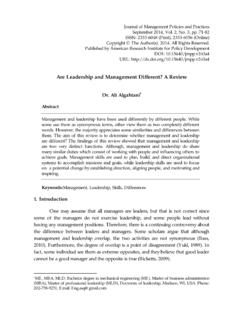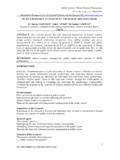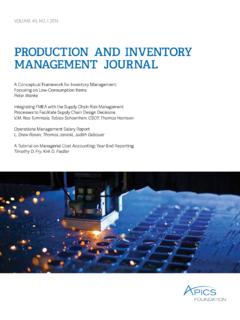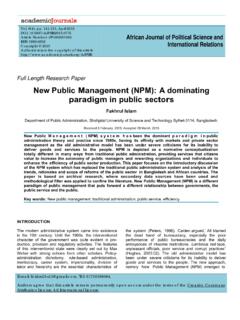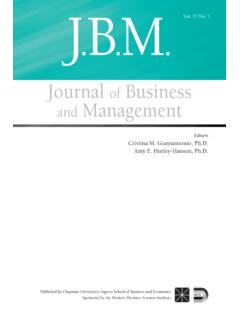Transcription of Journal of Homeland Security and Emergency Management
1 Volume8,Issue12011 Article3 Journal of Homeland Security andEmergency ManagementA Social Vulnerability Index for DisasterManagementBarry E. Flanagan,CDC/ATSDRE dward W. Gregory,CDC/ATSDRE laine J. Hallisey,CDC/ATSDRJ anet L. Heitgerd,CDC/NCHHSTPB rian Lewis,CDC/ATSDRR ecommended Citation:Flanagan, Barry E.; Gregory, Edward W.; Hallisey, Elaine J.; Heitgerd, Janet L.; and Lewis,Brian (2011) "A Social Vulnerability Index for Disaster Management ," Journal of HomelandSecurity and Emergency Management : Vol. 8: Iss. 1, Article at: 2011 Berkeley Electronic Press. All rights Social Vulnerability Index for DisasterManagementBarry E. Flanagan, Edward W. Gregory, Elaine J. Hallisey, Janet L. Heitgerd, andBrian , (SVI),from15censusvariablesatthecensustr actlevel, the impact of Hurricane Katrina on local :social vulnerability, Hurricane KatrinaAuthorNotes:Thefindingsandconclus ionsinthisreportarethoseoftheauthorsandd onotnecessarily represent the views of the Agency for Toxic Substances and Disease Registry.
2 Introduction For most of the twentieth century, disaster Management focused on the physical world, emphasizing infrastructure and technology. The concept of social vulnerability within the disaster Management context was introduced in the 1970s when researchers recognized that vulnerability also involves socioeconomic factors that affect community resilience (Juntunen 2005). This paper describes the development of a social vulnerability index (SVI) for use in disaster Management and examines its potential value by exploring the impact of Hurricane Katrina on local populations for illustration. Background and Rationale All regions of the United States have experienced disasters, both natural and anthropogenic. The hazards that precipitate these disasters will continue to occur in the future. Hazards may be large scale, such as hurricanes, forest fires, and earthquakes, or they may be relatively localized in extent, such as tornadoes, mudslides, or chemical spills.
3 Although hazard events may be relatively benign, they may also culminate in disaster severe physical injuries, emotional distress, loss of life, and substantial property damage to the point of destroying entire communities. In both the short- and long-term future, disasters can have devastating economic, health, and social consequences for affected areas and their inhabitants. Disaster Management research and practice often refer to a formula of the following type: Risk = Hazard * (Vulnerability Resources) where Risk is the likelihood or expectation of loss; Hazard is a condition posing the threat of harm; Vulnerability is the extent to which persons or things are likely to be affected; and Resources are those assets in place that will diminish the effects of hazards (Dwyer et al. 2004; UCLA Center for Public Health and Disasters 2006).
4 Yet disaster Management often only encompasses the physical hazard component. The social vulnerability component is usually ignored. Furthermore, the various disciplines approach the concept of vulnerability from different perspectives (Alwang et al. 2001). Disaster planning research, for instance, has often focused on infrastructure vulnerability, neglecting social vulnerability when considering the vulnerability component. The Federal Emergency Management Agency (FEMA), under contract with the National Institute of Building Sciences, has long provided HAZUS-MH software for use in disaster Management to map 1 Flanagan et al.: A Social Vulnerability Index for Disaster ManagementPublished by Berkeley Electronic Press, 2011 and display hazard data and the results of damage and economic loss estimates for buildings and infrastructure (FEMA 2009a). A widely used and valuable tool, HAZUS-MH also enables users to estimate the effects of earthquakes, hurricane winds, and floods on populations in general.
5 Until the release of the most recent version, HAZUS-MH , however, the software did not identify socially vulnerable populations. The current version now includes a component to address selected social issues, such as estimates of shelter requirements and displaced households, in disaster Management (FEMA 2009b). Exploring the manner in which hazards may affect the population at large is vital, but understanding how and where particularly socially vulnerable communities may be affected can help allocate resources more effectively during the disaster cycle phases of mitigation, preparedness, response, and recovery (Figure 1). This paper, therefore, addresses an important subcomponent of the disaster Management risk equation social vulnerability with the goal of improving all phases of the disaster cycle. Figure 1. The disaster cycle.
6 Vulnerability to hazards is influenced by many factors, including age or income, the strength of social networks, and neighborhood The hazards and vulnerability literature reveals that categories of people living in a disaster-stricken area are not affected equally. For example, evidence indicates that the poor are more vulnerable at all stages before, during, and after of a catastrophic event. The findings are similar for racial and ethnic minorities; 1 We focus on population groups and their overall vulnerability relative to other groups. We must avoid the ecological fallacy, making inferences or assumptions about individuals based upon characteristics of population groups. An individual s demographic characteristics per se do not cause him or her to be more vulnerable.
7 Nothing is inherent in one s race, ethnicity, income, or education level that precludes an appropriate response in an Emergency . All people are made up of a constellation of characteristics that enable them to assist in some situations but require assistance in others. None should be viewed merely as a so-called victim group or a so-called rescue group. ResponseRecoveryMitigationPreparednessDi sasterCycle2 JHSEM: Vol. 8 [2011], No. 1, Article 3 children, elders, or disabled people; and residents of certain types of housing, particularly high-rise apartments or mobile homes. Furthermore, such vulnerability factors often occur in combination (Morrow 1999). Population characteristics are an important indicator of everything from evacuation compliance during an event to successful long-term recovery after one with the socially vulnerable more likely to die in a disaster event and less likely to recover after one (Juntunen 2005).
8 The most vulnerable people are likely those whose needs are not sufficiently considered in the planning of local response and relief organizations. During emergencies, for example, real-time evacuation information is not generally provided to people with limited English proficiency, the hearing and visually impaired, and other special needs groups ( Department of Transportation 2006). Many low-income people in New Orleans were stranded in the wake of Hurricane Katrina because they had no personal transportation and public authorities did not provide Emergency mass transit. In mitigating and planning for emergencies, state, local, and tribal officials must identify socially vulnerable communities to provide those residents increased assistance over the course of a disaster. Although local authorities are in the best position to identify vulnerable communities, such agencies are commonly underfunded, understaffed, and stretched thin by ongoing health and social service responsibilities.
9 State agencies, on the other hand, even if sufficiently staffed and funded, may lack the systems in place to allocate resources as needed (APHA 2006; USGAO 2006). Municipalities should establish voluntary registration programs for the disabled, frail, or transportation disadvantaged (USGAO 2006; Town of Davie, FL 2007). A voluntary registration program is an important tool for Emergency response planning but such a measure may overlook individuals who are less likely to register. While considering this important issue of social justice, state and local officials must also consider cost savings when planning for emergencies. Effective mitigation and preparation decreases both human and economic loss related to providing social services and public assistance after a disaster.
10 Increasing recognition of the importance of identifying vulnerable populations has increased a demand for tools to do so, as evidenced in the current version of HAZUS-MH. The Centers for Disease Control and Prevention, National Center for Environmental Health, Office of Terrorism Preparedness and Emergency Response (OTPER) collaborated with the Agency for Toxic Substances and Disease Registry s Geospatial Research, Analysis, and Services Program to produce a social vulnerability index designed to assist OTPER-funded state partners in all phases of the disaster cycle. The index will help state, local, and tribal disaster Management officials identify the locations of their most vulnerable populations. This work builds on research that examines vulnerability as a social 3 Flanagan et al.: A Social Vulnerability Index for Disaster ManagementPublished by Berkeley Electronic Press, 2011 condition or a measure of the resilience of population groups when confronted by disaster (Cutter et al.)


